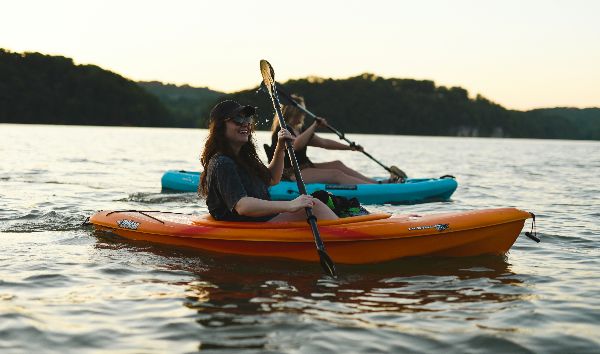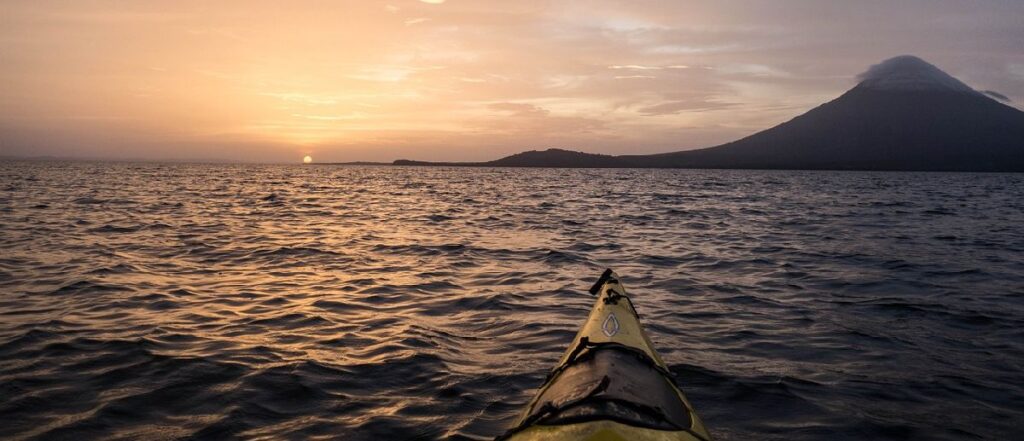Coastal kayaking is a type of kayaking that takes place in coastal waters, such as oceans, seas, bays, and estuaries. It involves paddling along the shoreline and exploring the diverse environments found in coastal areas.
As you glide through the waters, you’re likely to witness a diverse array of wildlife, from seabirds nesting on cliff faces to marine life in the clear waters below. Each paddle stroke brings a new perspective of the coastline, making this type of kayaking a unique way to connect with the natural world.The experience is different from river kayaking, where you have to face challenges posed by the river’s currents and obstacles, and often turbulent water conditions.
In this post, we will take you to some of the basics of choosing a touring kayak for your first coastal exploration adventures and give you some tips on where in the world you can begin your kayaking adventures- literally.
Touring Kayaks: Your Vessel For Coastal Exploration
Touring kayaks are designed for distance, stability, and the ability to handle a variety of water conditions, making them ideal for coastal kayaking adventures.
They offer a blend of speed, storage capacity, and comfort that can accommodate paddlers for day trips or extended journeys along the coast. Unlike their recreational counterparts, touring kayaks are longer, narrower, and often equipped with features like bulkheads and hatches for dry storage, rudders or skegs to aid in navigation, and adjustable seats for enhanced comfort during long paddles.
How to Choose the Right Touring Kayak
Choosing the right touring kayak is a crucial step in preparing for your coastal kayaking adventure.
The ideal kayak should match your skill level, body type, and the specific conditions you expect to encounter along the coast. Key factors to consider include:
- Length and Width: Longer kayaks tend to be faster and track better, while wider kayaks offer more stability. Beginners might prefer a slightly wider kayak for its stability, while more experienced paddlers may opt for a narrower, faster model.
- Material: Kayaks are made from various materials, with polyethylene being durable and affordable, composite materials like fiberglass and Kevlar offering lighter weight and better performance, and thermoformed plastics providing a good balance between the two.
- Storage and Deck Layout: For coastal journeys, ample storage space is essential for carrying gear, food, and safety equipment. Look for kayaks with well-designed hatches and deck rigging that allow easy access to your belongings while on the water.
- Comfort and Fit: A comfortable kayak is key for long days of paddling. Adjustable seats, footpegs, and thigh braces can help ensure a good fit, which is crucial for effective paddling and maneuverability.
Choosing the right touring kayak involves balancing these factors with your personal preferences and the specific demands of coastal kayaking. Test paddling different models and consulting with experienced kayakers or professionals at specialized kayak shops can help you make an informed decision.
Mastering Essential Coastal Kayaking Skills
Before setting out on a coastal kayaking journey, acquiring a set of essential skills is crucial for navigating the dynamic conditions you’ll encounter.
These skills not only enhance your enjoyment of the adventure but also ensure your safety and the safety of those with you.
- Paddling Techniques: Proficiency in various paddling techniques, including forward and reverse strokes, sweep strokes, and bracing, will help you maneuver your kayak effectively in coastal waters. Advanced techniques like edging and rolling can also be invaluable in dealing with waves and currents.
- Navigation: Coastal kayaking often involves paddling out of sight of land, making navigation skills essential. Understanding how to use a compass, read nautical charts, and utilize GPS devices will help you keep track of your position and plan your route effectively.
- Understanding Weather and Tides: The coastal environment is greatly influenced by weather and tidal conditions. Learning to interpret weather forecasts and tidal charts is crucial for planning your trip and avoiding potentially dangerous situations.
- Rescue Skills: Knowing how to perform self-rescues and assist in the rescue of others is vital. This includes being able to re-enter your kayak in deep water and use a bilge pump or sponge to remove water from your kayak.
Prioritizing Safety On Coastal Kayaking Trips
Safety should always be the top priority when planning and undertaking a coastal kayaking adventure. Taking the right precautions can significantly reduce risks and ensure a memorable experience.
- Wear a Personal Flotation Device (PFD): Always wear a properly fitted PFD while kayaking, regardless of your swimming abilities or the conditions.
- Carry Communication Devices: Have a waterproof VHF radio and a fully charged cell phone in a waterproof case. These devices are essential for emergency communication, especially in remote coastal areas.
- Inform Someone of Your Plan: Always let someone know your planned route and expected return time. This simple step can be crucial in case of an unexpected situation.
- Pack Essential Safety Gear: Your kayak should be equipped with safety gear, including a paddle float, bilge pump, first-aid kit, repair kit, and signaling devices such as a whistle and flares.
- Stay Within Your Skill Level: Choose routes that match your experience and skill level. Avoid paddling in conditions or areas that exceed your abilities, and be prepared to turn back if conditions worsen.
By focusing on these essential skills and safety measures, kayakers can navigate the challenges and enjoy the rewards of coastal exploration with confidence. These preparations, combined with the right equipment and a respect for the natural environment, set the stage for a truly unforgettable coastal kayaking experience.

Kayaking In Eastern Europe: A Hidden Gem For Paddlers
Eastern Europe offers some of the most pristine and under-explored kayaking destinations in the world. From the tranquil waters of Masuria in Poland to the vibrant blue currents of Slovenia’s Soca Valley, Eastern Europe is a kayaker’s paradise, rich in natural beauty and cultural heritage.
Masuria, Poland: The Land Of A Thousand Lakes
Masuria, often referred to as the “Land of a Thousand Lakes,” is a serene kayaking destination in Poland.This region is characterized by its vast network of lakes and rivers, making it an ideal spot for paddlers of all levels.
The Krutynia River, in particular, is renowned for its 100 km long kayaking trail, which meanders through lush forests and past historic sites. It’s a place where time slows down, allowing paddlers to immerse themselves in the tranquility of nature and the authenticity of rural Polish life.
The trail offers various segments suitable for both day trips and extended journeys, with accommodations and kayak rentals readily available along the route.
Slovenia: Alpine Rivers And Emerald Lakes
Slovenia, with its alpine landscapes and crystal-clear waters, presents another exceptional kayaking experience.
The Soca Valley is a highlight, where the river’s striking turquoise waters flow through the heart of the Triglav National Park, offering paddlers breathtaking views of the surrounding mountains.
This region is not only a feast for the eyes but also a playground for kayakers seeking a mix of tranquil waters and mild rapids. Beyond the Soca River, Lake Bled and Lake Bohinj offer serene paddling experiences, with the former known for its picturesque church-topped islet and medieval castle.
Slovenia’s commitment to preserving its natural and cultural heritage makes it a must-visit for eco-conscious paddlers.
Final Remarks
Kayaking embodies the spirit of adventure and exploration, offering paddlers a unique way to experience the world’s coastlines.From the lakes of Masuria in Poland to the vibrant waters of Slovenia’s Soca Valley, kayakers are invited to discover the hidden gems of Eastern Europe and beyond. Kayaking not only targets the body and mind but also inspire a deep appreciation for the natural beauty and cultural richness of our planet. By prioritizing safety, respecting nature, and embracing the adventure, kayakers can forge unforgettable memories on the water, connecting with the environment and cultures in a profoundly personal way.

